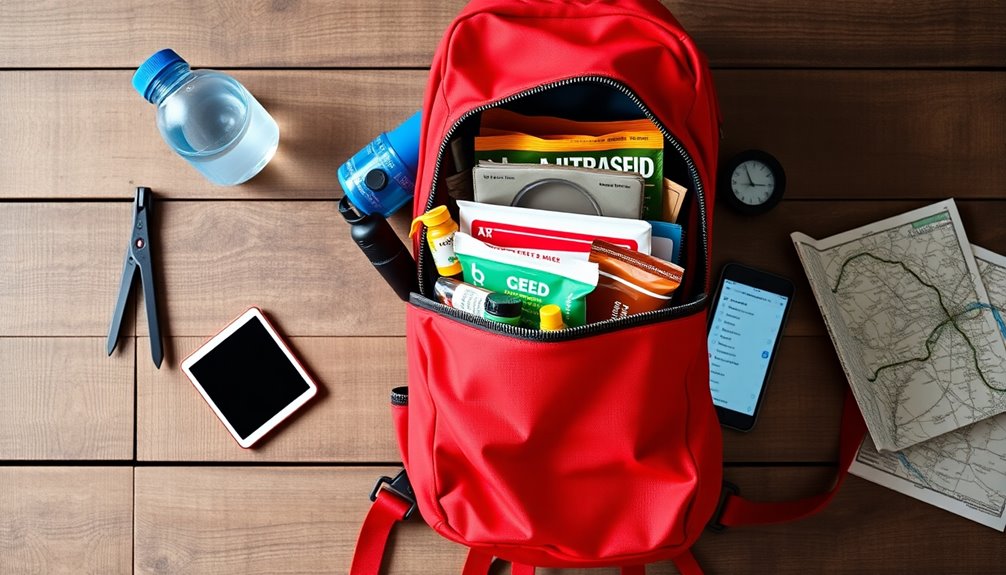To ensure your safety in emergencies, start by creating a plan tailored to your local risks, like hurricanes or wildfires. Next, build an emergency kit with essentials: water, non-perishable food, a flashlight, a first aid kit, and important documents stored safely. Don't forget supplies for pets! Stay informed about local hazards and practice your emergency plans to boost familiarity. Engage with community resources for support and training. Remember, building emotional resilience is just as crucial. If you want to explore more strategies that can enhance your preparedness, keep going and discover additional key insights.
Key Takeaways
- Create a comprehensive emergency kit with essentials like water, food, and first aid supplies for at least three days.
- Develop a personalized emergency plan that includes local risks, assigned roles, and regular practice of procedures.
- Stay informed about local hazards and participate in community preparedness initiatives to enhance collective safety.
- Address the needs of vulnerable groups in your emergency planning to ensure everyone's safety during crises.
- Build mental resilience through coping strategies and emotional support systems to effectively manage stress during emergencies.
Introduction
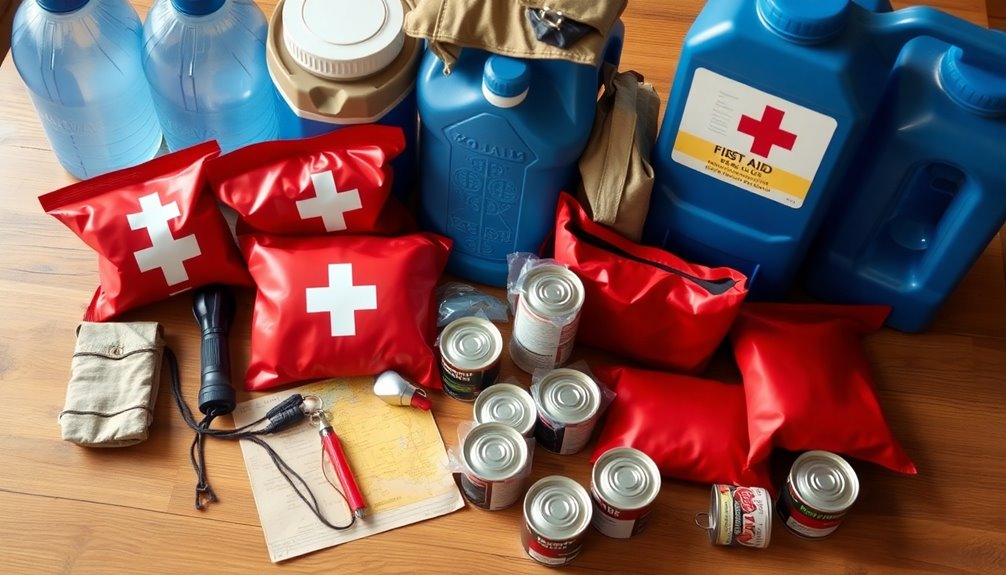
Emergency preparedness is all about knowing what to do when disaster strikes.
You need to clarify your goals and understand the key concepts that will keep you and your community safe.
Key Emergency Preparedness Concepts
Preparedness strategies are essential for navigating the uncertainties of natural disasters. Understanding the specific risks in your region, like hurricanes or wildfires, helps you create a tailored emergency plan.
The Red Cross highlights three key steps: getting a kit, making a plan, and staying informed. These actions can significantly bolster your confidence during emergencies.
Don't forget that vulnerable groups—children, people with disabilities, and older adults—need special considerations in your emergency plan to ensure their safety and well-being.
Additionally, participating in community initiatives, like the Red Cross Ready Rating™ program, promotes collective safety.
Regularly practicing your emergency plan and assessing your preparedness can enhance your readiness and ensure that everyone in your family knows their roles when disaster strikes.
Clarify Emergency Preparedness Goals
Setting clear goals for emergency preparedness is crucial for effectively managing potential crises. By establishing these goals, you and your family can identify specific risks and the necessary steps to mitigate them.
The Red Cross emphasizes the importance of creating a disaster plan, which includes recognizing local emergencies and assigning roles to each family member. When you set preparedness goals, you enhance your confidence, knowing you're better equipped to handle unexpected situations.
Regularly practicing your emergency plans ensures everyone in your household is familiar with the procedures, reducing anxiety during actual emergencies.
Utilize resources like the Red Cross Emergency app and survival kit guidelines to help you achieve your emergency preparedness goals and stay safe in any situation.
Defining Emergency Preparedness Essentials
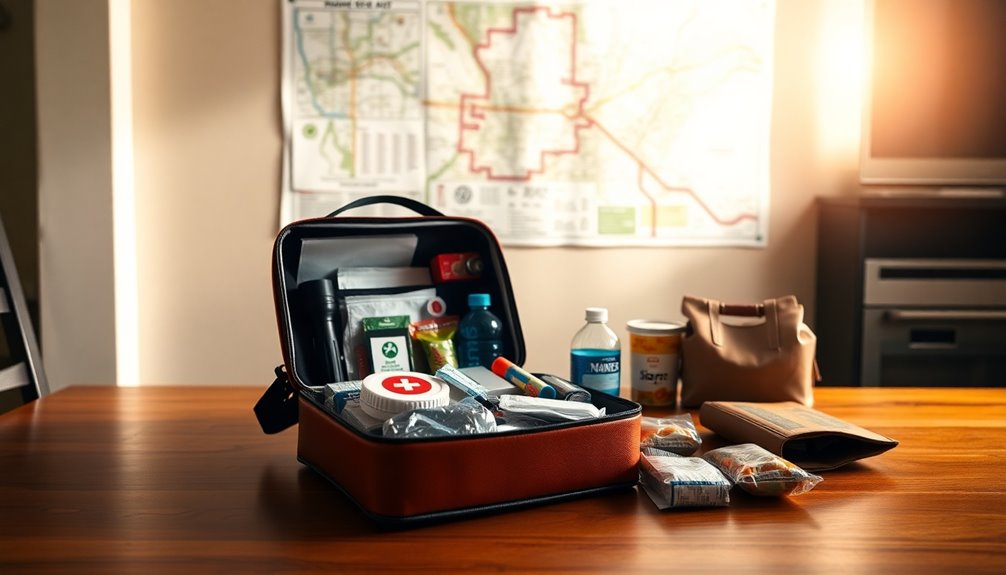
Being ready for unexpected situations is crucial for ensuring the safety of you and your loved ones. Start by creating a comprehensive emergency plan that addresses potential local disasters, making sure everyone understands their roles and responsibilities.
Stock a well-equipped emergency kit with essentials like water, non-perishable food, a flashlight, batteries, a first aid kit, and personal medications to last at least 72 hours.
Identify the specific risks in your community—hurricanes, earthquakes, or wildfires—and tailor your plans accordingly.
Regularly practice emergency drills with your family to reinforce the plan and ensure everyone knows how to respond effectively.
Lastly, utilize free resources, like the Red Cross Emergency app, to receive real-time alerts and stay informed during an emergency situation.
Mental Resilience During Crises

When crises hit, your emotional stability can make all the difference in how you respond.
By staying aware of local hazards and preparing mentally, you can bolster your resilience and better handle stressful situations.
It's crucial to recognize that building this mental strength is just as important as physical preparedness. Additionally, developing a cooperative co-parenting plan can provide emotional support during family crises, helping to maintain stability for all involved.
Emotional Stability During Crises
During crises, maintaining emotional stability is crucial for navigating the challenges that arise. You may experience heightened anxiety and stress, making it essential to practice self-care and stick to your routines.
Engaging in open communication about your fears and concerns before a crisis can enhance your mental resilience, helping you cope better when emergencies strike. Utilize resources like the Red Cross's free Emergency app for real-time updates, which can reduce uncertainty and anxiety.
Building a support network of family, friends, and community members allows you to share experiences and feelings, fostering emotional stability during crises.
Lastly, developing coping strategies—like mindfulness or relaxation techniques—equips you with the tools to manage stress effectively. Incorporating mindfulness practices can significantly improve your emotional well-being during challenging times.
Local Hazard Awareness
Understanding local hazards is key to building mental resilience in the face of crises. By developing local hazard awareness, you prepare yourself for events like earthquakes or floods that could impact your community.
Familiarizing yourself with community-specific emergency plans can significantly reduce anxiety and enhance your response effectiveness during a disaster. Engage in regular discussions about local risks with your family to reinforce a proactive mindset.
Planning ahead by practicing emergency scenarios fosters confidence, enabling you to stay calm and focused when crisis strikes. Additionally, utilizing resources like the Emergency Resource Library offers valuable information on coping strategies and mental health support, ensuring you're well-equipped to handle emergencies and maintain your mental resilience. Implementing strategies from your bug out bag can further enhance your preparedness for unexpected situations.
Emergency Kit Essentials
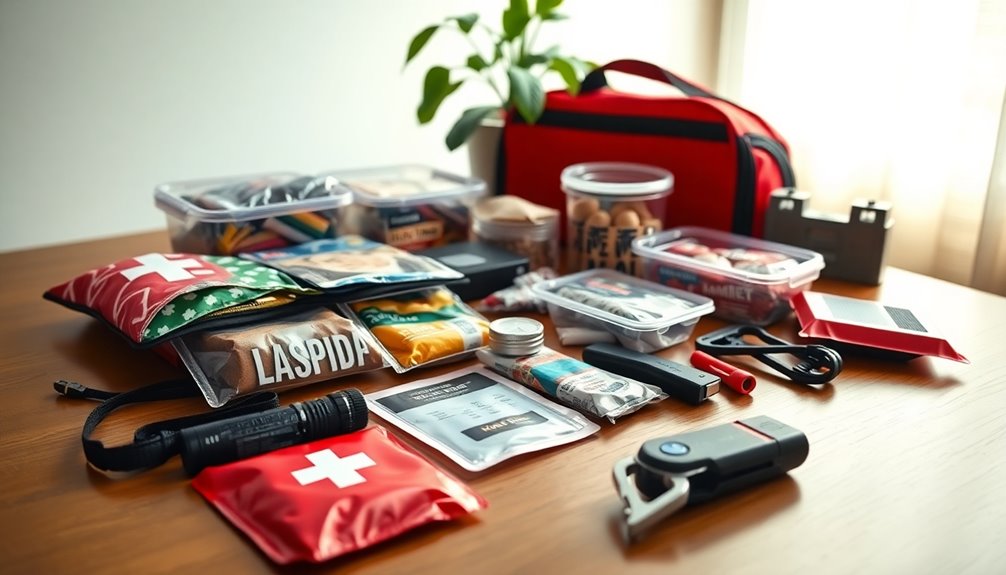
In the face of an emergency, having a well-stocked emergency kit can make all the difference. Your emergency kit essentials should include one gallon of water per person per day for at least three days and non-perishable food.
Don't forget a flashlight with extra batteries, a first aid kit, and a whistle to signal for help. A multi-tool or Swiss Army knife is also crucial for various needs.
Keep important personal documents, like identification and medical records, in a waterproof container. The Red Cross recommends adding a battery-powered or hand-crank radio to stay informed.
If you have pets, make sure to pack their food, water, and any necessary medications to ensure their safety, too.
Emergency Supplies Checklist

When preparing for an emergency, having a comprehensive supplies checklist is crucial to ensure you're ready for any situation.
Start with the essentials: one gallon of water per person per day for at least three days, and non-perishable food to sustain you.
Include a flashlight and a first aid kit for immediate medical needs. It's wise to have a battery-powered or hand-crank radio to stay informed, along with extra batteries.
Don't overlook personal hygiene items, tools like a multi-tool, duct tape, and plastic sheeting.
Be sure to add important documents, cash, and medications.
Regularly review and update your emergency supplies checklist, rotating food items and replacing expired products to keep your kit effective and reliable.
Community Engagement Techniques

Preparing your emergency supplies is just the beginning; engaging your community can amplify your efforts and enhance overall safety. You can foster a culture of preparedness by collaborating with local organizations and schools on initiatives that promote readiness.
Consider utilizing the American Red Cross Ready Rating™ program to help businesses assess their emergency plans. Enhance community involvement through Red Cross Kids Videos on YouTube, making it fun for children to learn about safety.
Hosting workshops and drills can raise awareness and readiness among residents. Additionally, partnering with local agencies to distribute materials and conduct training sessions can strengthen community ties, ensuring everyone knows how to respond effectively during emergencies.
These community engagement techniques can create a more resilient environment for all.
Barriers to Effective Communication
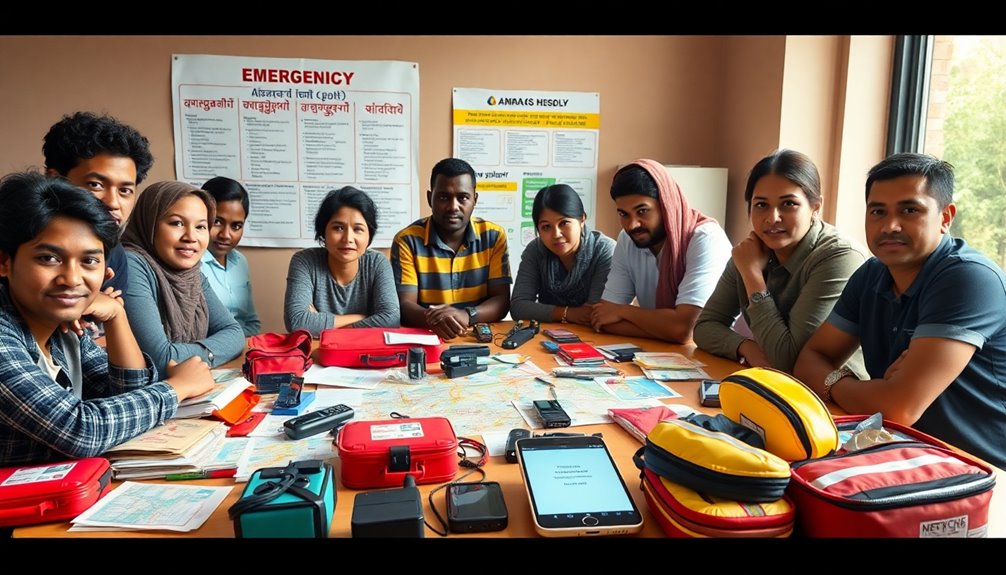
When emergencies strike, effective communication is crucial, but various barriers can complicate this process.
You might encounter language differences, hearing impairments, or even simple confusion due to stress and chaos.
Understanding these challenges can help you implement better strategies and training to ensure everyone stays informed and connected.
Emergency Response Training Benefits
Effective communication is the backbone of successful emergency response training, especially when barriers can complicate crisis situations.
By participating in emergency response training, you can learn to navigate language differences, ensure accessible information for everyone, and combat misinformation effectively. These training programs highlight the importance of clear messaging and using multiple communication channels, like text alerts and local radio, to reach diverse audiences.
You'll also become familiar with your roles and responsibilities, enhancing your ability to communicate under pressure. Incorporating feedback from your community into these training sessions helps identify potential barriers and improve overall preparedness.
Ultimately, the emergency response training benefits extend beyond personal safety, fostering trust and clarity during chaotic events.
Effective Communication Strategies
During emergencies, communication can easily break down due to various barriers that hinder the flow of critical information.
Language differences can leave non-English speakers uninformed, while limited access to technology may prevent vulnerable populations from receiving alerts.
Hearing and vision impairments further complicate matters, emphasizing the need for inclusive communication strategies.
Stress and anxiety can cloud judgment, making clear and concise messaging essential.
To improve effective communication strategies, involve diverse community groups in preparedness initiatives.
Gathering feedback helps identify specific barriers and ensures everyone receives vital information. Additionally, understanding the cultural significance of sign language can enhance communication with the Deaf community during emergencies.
Survivor Stories From Recent Disasters
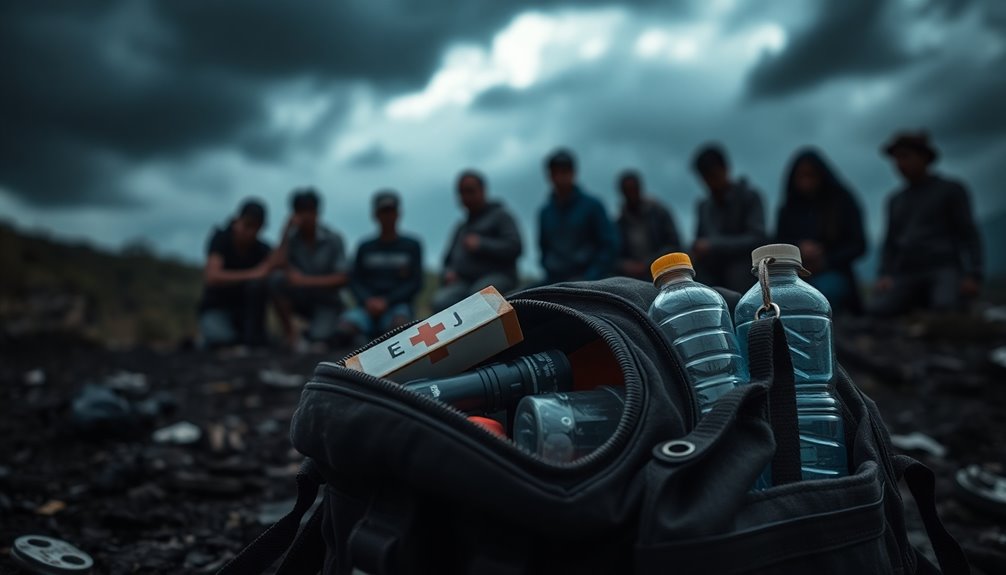
Survivor stories from recent disasters reveal the incredible resilience and resourcefulness of individuals who were well-prepared. Many people affected by disasters emphasize how emergency plans and kits saved their lives.
For instance, those who faced hurricanes often highlight the importance of having evacuation routes mapped out, which allowed them to reach safety quickly. Similarly, wildfire survivors stress that having an emergency kit ready, complete with essential supplies and documents, significantly sped up their recovery.
Community support also plays a vital role; neighbors banding together to help each other can make a huge difference.
Lastly, maintaining communication with loved ones during chaotic situations helps many cope with the psychological impacts of disasters, underscoring the need for preparedness in every aspect.
Conclusion
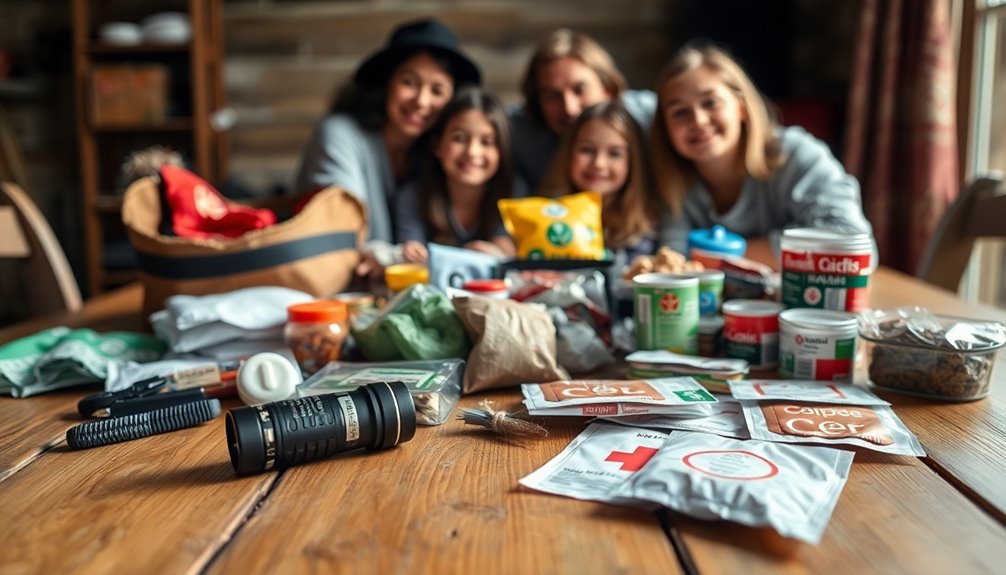
In today's unpredictable world, being prepared for emergencies isn't just a choice; it's a necessity.
You need to create a comprehensive emergency plan that includes effective communication strategies, designated meeting points, and specific roles for each family member. Regularly practicing this plan will enhance your family's readiness and highlight areas for improvement.
Don't forget to establish an emergency contact list, ensuring everyone knows whom to reach out to during a crisis. Involve vulnerable groups in your planning, and consider community initiatives to strengthen resilience.
Utilizing available resources like the free Emergency app can provide vital information tailored to your local risks. Being proactive today means safeguarding your loved ones for tomorrow's uncertainties.
Additional Resources

Preparation is key when it comes to emergencies, and numerous resources are available to help you enhance your readiness.
The American Red Cross offers a free Emergency app in both English and Spanish, providing vital information for various emergencies. You can access the Emergency Resource Library for detailed guidance on preparing for disasters like hurricanes, wildfires, and floods.
Additionally, Red Cross Kids Videos on YouTube make teaching children about emergency preparedness engaging and fun.
If you run a business, the Red Cross Ready Rating™ program helps assess your preparedness levels and implement necessary improvements.
Finally, explore resources for creating survival kits and developing effective emergency plans tailored to your needs and community.
Don't wait—get prepared today!
Frequently Asked Questions
What Are the 5 Steps of Emergency Preparedness?
To prepare for emergencies, you should focus on five key steps.
First, get a kit with essentials like food, water, and medical supplies.
Next, make a plan that includes meeting points and evacuation routes.
Stay informed about local hazards and alerts through reliable sources.
Don't forget to practice your plan regularly, ensuring everyone knows their roles.
Finally, review your preparedness often to keep everything up-to-date and effective for any situation.
What Are the 7 Steps in the Emergency Action Plan?
The seven steps in an Emergency Action Plan (EAP) are crucial for ensuring safety.
First, identify potential emergencies that could arise in your environment.
Next, conduct risk assessments to understand their impact.
Establish a chain of command, then create an emergency response team to lead efforts.
Develop communication plans, train staff regularly, and review the plan to keep it updated and effective.
What Step Should You Take to Ensure Your Safety in an Emergency Situation?
To ensure your safety in an emergency, start by creating a family emergency plan.
Identify communication methods and assign responsibilities to each family member. Practice drills regularly so everyone knows what to do.
Assemble a survival kit with essentials like water, food, and first aid supplies. Plus, choose two meeting points for regrouping after an emergency.
Stay informed through reliable sources, like the Red Cross Emergency app, to get timely alerts and resources.
What Are the 4 Principles of Emergency Preparedness?
The four principles of emergency preparedness are straightforward.
First, you need to get a kit filled with essential supplies like food and water.
Next, make a plan that identifies potential emergencies and assigns roles to family members.
Being informed is crucial; know the risks in your area and how to respond.
Lastly, practice regularly to ensure everyone's familiar with the procedures, boosting confidence and readiness for any situation that may arise.

